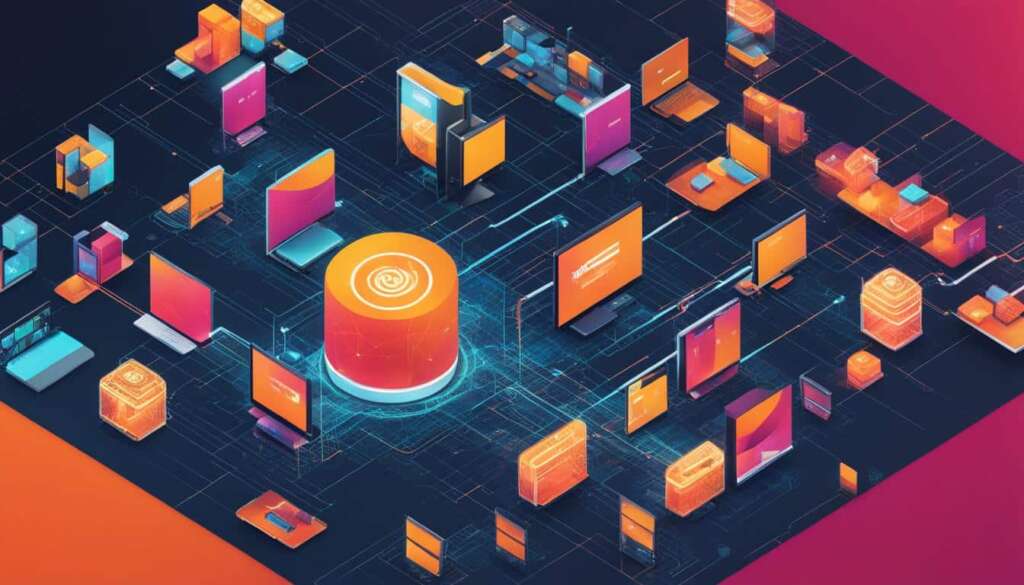Table of Contents
Edge computing is a distributed IT architecture that processes client data at the periphery of the network, close to the source. In today’s technology infrastructures, where real-time data processing is essential, edge computing has become a crucial component. Unlike traditional computing models that rely on centralized data centers and the internet, edge computing moves storage and compute resources closer to the data source, enabling real-time processing and analysis. Only the results of the computation are sent back to the main data center for further review and human interaction.
Edge computing is reshaping IT and business computing with several benefits. It significantly reduces latency, increases bandwidth efficiency, and improves scalability. Additionally, edge computing enhances data privacy and security, addressing the challenges posed by handling large volumes of real-world data. By bringing processing power closer to the source, edge computing unlocks new possibilities for innovation and enables applications like self-driving cars, augmented reality/virtual reality, and smart cities.
How Does Edge Computing Work?
Edge computing is a groundbreaking approach that optimizes data processing by bringing computing resources closer to the location where data is generated. Unlike traditional enterprise computing, which involves transmitting data across a wide area network (WAN) to a centralized data center for processing, edge computing shifts the focus to the edge of the infrastructure, deploying storage and computing resources near the data source.
This location-based processing significantly reduces the strain on the global internet caused by transmitting large volumes of data. It also enables faster and more reliable services, as data no longer needs to travel long distances to reach a central data center.
Edge computing is especially well-suited for scenarios where data is generated in remote or inhospitable locations, such as oil rigs, mining sites, or rural areas. By processing data at the edge, organizations can achieve real-time or time-sensitive processing, even in environments with limited connectivity or high latency.
This diagram illustrates how edge computing works:

Edge computing enables the processing of data closer to the source, reducing latency and improving overall system performance. It is a critical technology that unlocks the full potential of IoT, enabling real-time decision-making and empowering innovative applications that require immediate data processing.
Now let’s take a closer look at the key differences between edge computing, cloud computing, and fog computing.
Edge vs. Cloud vs. Fog Computing
Edge computing, cloud computing, and fog computing are all related to distributed computing and the physical deployment of compute and storage resources in relation to the location of data. While there is some overlap between these concepts, they have distinct characteristics.
Edge computing involves deploying computing and storage resources at the location where data is produced, bringing processing closer to the data source. This enables faster processing and analysis of data, reducing latency and improving real-time decision-making. Edge computing is particularly beneficial for applications that require immediate responses, such as autonomous vehicles or remote monitoring systems.
Cloud computing, on the other hand, relies on large centralized data centers to provide scalable compute and storage resources. It involves storing and processing data in remote data centers accessed through the internet. Cloud computing offers flexibility, scalability, and cost-efficiency, making it suitable for tasks that don’t require real-time processing or have high latency tolerance.
Fog computing is an intermediate approach that places compute and storage resources within the data, but not necessarily at the data source. It extends cloud computing capabilities to the network edge, providing localized processing and storage closer to the end-users. Fog computing is advantageous when real-time processing is required, but the data source is not directly accessible. It helps reduce network congestion, improve response times, and optimize bandwidth utilization.
Edge computing brings processing closer to the data source, cloud computing relies on centralized data centers, and fog computing provides localized processing at the network edge.
Understanding the differences between edge computing, cloud computing, and fog computing is crucial when considering the most suitable computing model for specific use cases. Factors such as data location, latency requirements, scalability needs, and cost considerations should all be taken into account to determine the optimal approach for a given application or environment.
Comparing Edge, Cloud, and Fog Computing
| Aspect | Edge Computing | Cloud Computing | Fog Computing |
|---|---|---|---|
| Physical Deployment | At the location of data source | Centralized data centers | Network edge |
| Processing | Real-time, near the data source | Remote processing via the internet | Localized processing at the network edge |
| Latency | Lowest | Higher than edge computing | Lower than cloud computing |
| Scalability | Limited by local resources | Highly scalable | Limited by fog node capacity |
| Data Location | Close to the data source | Centralized data centers | Between the data source and cloud |
| Use Cases | Real-time analytics, IoT, autonomous systems | Data storage, software development, web applications | Smart cities, industrial IoT, real-time monitoring |
Why Edge Computing Matters
Edge computing plays a vital role in the modern technology landscape. Its suitable architecture for distributed computing addresses the challenges posed by large volumes of data and enables real-time processing. Unlike traditional centralized computing models, which struggle to handle time-sensitive applications, edge computing allows for rapid decision-making and enhances user experiences significantly. By reducing latency and increasing data relevance at each touchpoint, edge computing ensures efficient processing of high data volumes.
Meeting Data Challenges
One of the key advantages of edge computing is its ability to overcome data challenges. With the increasing amount of data generated in this digital age, conventional computing models have become inadequate. Edge computing provides the infrastructure needed to process and respond to data in real-time. This is especially crucial for time-sensitive applications that require immediate action or analysis. By bringing processing closer to the data source, edge computing eliminates the delays associated with transmitting data to centralized data centers, resulting in faster and more efficient operations.
Addressing the Needs of Real-Time Processing
Real-time processing is a critical requirement for many applications across industries. Edge computing enables real-time processing by bringing computational resources closer to the point of data generation. This proximity allows for quicker analysis and decision-making, enabling systems to respond in near real-time. Time-sensitive applications such as self-driving cars, augmented reality/virtual reality experiences, and smart cities heavily rely on edge computing to deliver high-performance and responsiveness.
Enhancing Data Privacy and Security
Data privacy and security are paramount concerns in today’s digital world. By processing data locally at the edge, edge computing ensures that sensitive information can be handled securely. Instead of transmitting all data to centralized data centers or the cloud, edge computing allows for localized processing and filtering of data. This approach minimizes the risk of data breaches and unauthorized access, enhancing data privacy and security.
Enabling Autonomous Operations
Edge computing is a critical enabler of autonomous operations. By processing and analyzing data at the edge, autonomous systems can make decisions and operate independently, without constant reliance on cloud connectivity. This capability is particularly valuable in remote locations or situations where internet connectivity may be limited or unreliable. Autonomous vehicles, for example, need edge computing to process sensor data in real-time and make split-second decisions without depending on continuous cloud connectivity.

Edge Computing Use Cases
Edge computing is revolutionizing various industries by bringing computing power closer to the end user or data source. Here are some notable use cases where edge computing is proving to be beneficial:
1. IoT Applications
Edge computing plays a crucial role in the success of Internet of Things (IoT) applications by enabling real-time decision-making and reducing latency. By processing data closer to the source, it improves the efficiency and responsiveness of IoT devices and systems. This is especially important for time-sensitive applications such as smart homes, industrial automation, and predictive maintenance.
2. Mobile Technologies
Edge computing offers solutions for latency and service failure issues experienced in mobile technologies. By bringing computation and data storage closer to the network edge, mobile devices can provide faster and more reliable services. This is particularly beneficial for applications that require rapid data processing, such as augmented reality and real-time navigation.
3. Telecommunications
Modernizing networks and deploying services at the network edge is a critical aspect of the telecommunications industry. Edge computing allows telecom providers to process data locally, reducing reliance on centralized data centers and improving the overall user experience. It enables faster content delivery, enhanced network capabilities, and more efficient usage of resources.
4. Retail
Edge computing offers significant advantages for the retail industry. By deploying edge computing infrastructure in retail stores, businesses can create superior customer experiences and optimize operations. For example, real-time data processing enables personalized product recommendations, efficient inventory management, and frictionless checkout processes.
5. Healthcare
Edge computing is transforming healthcare by facilitating advanced medical procedures and improving patient care. In surgical applications, it enables robot-assisted surgery, making procedures less invasive and enhancing precision. Edge computing also enables the continuous monitoring of patients’ vital signs, ensuring timely interventions and reducing response times in critical situations.
These use cases showcase the versatility and impact of edge computing across industries. By leveraging the power of edge computing, businesses can unlock new possibilities for innovation and efficiency.
Benefits of Edge Computing
Edge computing offers several benefits that make it a compelling choice for many organizations. Its ability to provide rapid response times is critical for applications that require real-time or extremely rapid results, such as self-driving cars or telesurgery. Edge computing also helps handle high data volumes more efficiently, reducing transmission costs and network limitations. It addresses privacy concerns by allowing sensitive data to be processed locally without being sent to the cloud. Additionally, edge computing is advantageous for remote areas with limited connectivity, as it enables end-to-end processing within the local environment. It also offers cost optimization and supports autonomous operations by ensuring continuous functionality even without constant connectivity to the cloud.
In today’s digital landscape, the need for rapid decision-making and real-time data processing is paramount. Edge computing provides a solution by bringing processing power closer to where data is generated, enabling unprecedented levels of efficiency and speed. Whether it’s analyzing data from IoT devices or processing information in remote areas with limited connectivity, edge computing delivers on its promise of high-performance computing at the edge of the network.
One of the key advantages of edge computing is its rapid response capabilities. Applications that rely on real-time or near real-time data processing, such as autonomous vehicles or telemedicine, require swift and accurate responses. Edge computing enables these applications to process data locally, minimizing latency and ensuring timely actions. This capability is crucial in situations where delays can have significant consequences or jeopardize safety.
“Edge computing enables rapid decision-making and improves user experiences by reducing latency and increasing the relevance of data at each touchpoint.”
Another significant benefit of edge computing is its ability to handle high data volumes efficiently. With the rise of IoT devices and sensors, the amount of data generated has skyrocketed, straining traditional network infrastructure. Edge computing offloads the processing and analysis of data from the central data center to the edge, reducing the burden on the network and allowing for more scalable and cost-effective solutions.
Privacy is a growing concern in the digital age, and edge computing offers a solution to address these concerns. By enabling data to be processed locally, sensitive information can stay within the confines of the local environment, minimizing the risk of data breaches or unauthorized access. This is particularly important for industries such as healthcare or finance, where data privacy regulations are stringent.
Edge computing is especially advantageous for remote areas with limited connectivity. In these regions, maintaining constant connectivity to a centralized data center is challenging and expensive. Edge computing allows for end-to-end processing within the local environment, ensuring continuous functionality even without a stable internet connection. This capability opens up possibilities for digital services and solutions in previously underserved areas.
Furthermore, edge computing offers cost optimization benefits by reducing the need for expensive network infrastructure and bandwidth. By processing data at the edge, organizations can minimize data transmission costs, especially when dealing with large data volumes. This cost sensitivity makes edge computing an attractive option for businesses looking to maximize their IT investments.
Finally, edge computing supports autonomous operations by enabling critical functions and decision-making to occur even without constant connectivity to the cloud. In scenarios where reliable and continuous operations are essential, such as autonomous vehicles or industrial IoT applications, edge computing ensures that these systems can operate autonomously and make decisions locally.
Edge Computing Examples
Edge computing is revolutionizing industries by enhancing user experiences, enabling optimized operations, and fostering innovation. In the retail sector, edge computing plays a pivotal role in facilitating frictionless store checkout experiences. By processing data locally using advanced AI algorithms, edge computing provides real-time insights that enhance customer experiences while optimizing inventory management. This ensures smoother transactions and improved customer satisfaction.
The healthcare industry also leverages edge computing to improve patient outcomes. A notable example is the implementation of robot-assisted surgery, where edge computing enables real-time data processing and analysis. By reducing latency and enabling rapid decision-making, edge computing makes surgical procedures less invasive, enhancing precision and patient safety.
Aside from retail and healthcare, edge computing finds application in various other sectors. In entertainment, it enables digital production and consumption by processing and delivering content closer to end-users, ensuring seamless experiences. Edge computing also facilitates extended reality experiences, such as augmented reality and virtual reality, by providing low-latency and high-bandwidth services.
Furthermore, edge computing ensures privacy protection by allowing sensitive data to be processed locally, minimizing the risks of data breaches. It also guarantees service continuity and autonomy in mission-critical and remote applications where constant connectivity to the cloud may be challenging.
The combination of edge computing with other technologies like 5G and cloud computing further enhances these use cases and paves the way for accelerated innovation across various industries. As organizations recognize the transformative potential of edge computing, they are embracing this technology to unlock optimized user experiences, improve operational efficiency, and drive continuous advancement.
FAQ
What is edge computing?
Edge computing is a distributed IT architecture that processes client data at the periphery of the network, close to the source. It enables real-time data processing and addresses the challenges of handling large volumes of data.
How does edge computing work?
Edge computing works by moving computing resources closer to the location where data is produced. Instead of transmitting data across a wide area network to a centralized data center, storage and computing resources are deployed near the data source, reducing latency and improving reliability.
What is the difference between edge computing, cloud computing, and fog computing?
Edge computing involves deploying computing and storage resources at the location where data is produced, whereas cloud computing relies on centralized data centers, and fog computing places resources within the data but not necessarily at the source.
Why is edge computing important?
Edge computing provides a suitable architecture for distributed computing that supports real-time processing and addresses the challenges of handling large volumes of data. It enables rapid decision-making, reduces latency, and enhances user experiences.
What are the use cases for edge computing?
Edge computing has a wide range of use cases, including IoT applications, mobile technologies, telecommunications, retail, and healthcare. It enables real-time decision-making, improves customer experiences, and supports autonomous operations.
What are the benefits of edge computing?
Edge computing offers benefits such as rapid response times, efficient handling of high data volumes, data privacy, support for remote areas with limited connectivity, cost optimization, and autonomous operations.
Can you provide some examples of edge computing?
Edge computing is already being implemented in various industries. In retail, it optimizes inventory management and provides a superior customer experience. In healthcare, it facilitates robot-assisted surgery and improves patient outcomes.













